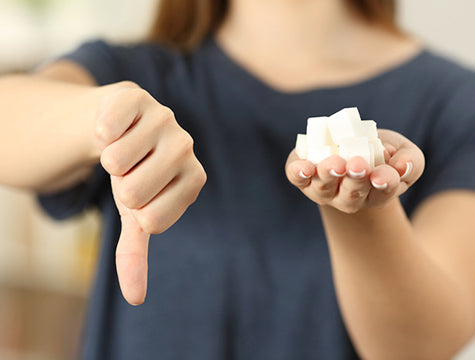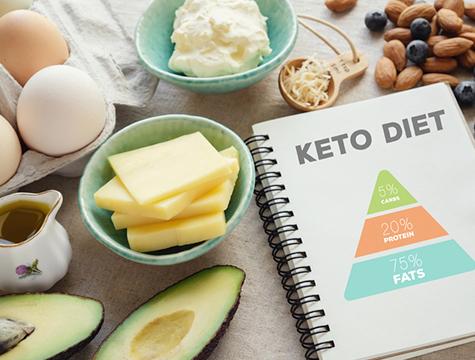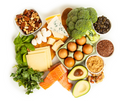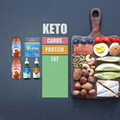Health-conscious Americans have turned to ketogenic (keto) diets to lose weight and live healthier lives. There are several variations on the keto diet, each allowing various amounts of carbohydrates, but for this discussion, we’ll be referring to the basic ketogenic diet of 75% fat, 20% protein, and 5% carbs/sugars.
What Is the Keto Diet?
There are three types of carbohydrates: sugars, starches, and fiber.
- Sugars – During digestion, the body breaks down complex sugars (disaccharides) such as sucrose and lactose into simple sugars (monosaccharides) such as glucose and fructose. Simple sugars are small molecules that can be absorbed directly by the body and used as a source of quick energy.
- Starches – Starches are large, complex molecular chains (polysaccharides), which the body must break down into simple sugars to make use of them.
- Fiber – The body can’t extract anything from fiber. Since it can’t be broken down during digestion, it passes through.

The human body uses sugar for energy. What does the body do if it has no ready supply of sugar? It finds an alternative fuel source in molecules called “ketones.” Ketones are produced by the liver from fat that the body and—most importantly—the brain can use as an energy source. (The ketogenic diet was originally used to treat epilepsy because it greatly reduced epileptic seizures in children.)
Once the body stops using sugar for energy and starts producing ketones for the body to burn, it enters a metabolic state known as ketosis, in which the body uses fat as its primary fuel supply.
With the keto diet, food intake is restricted to low- or no-carbohydrate items: foods such as meat, fish, eggs, nuts, berries, some vegetables, and some dairy products. Ideally, carb intake should be below 20 grams per day. As the body begins using fat as an energy source, all the benefits of eliminating dietary sugars—including weight loss and reduced risk of heart disease—will begin.
The Keto Diet and Vegetarianism
Vegetarians can take advantage of the keto diet, but will need to be certain they don’t become deficient in protein and some essential fats, vitamins, and minerals. Vegetarians who are looking for a list of keto-friendly veggies need only keep one rule in mind: generally, above-ground vegetables (such as spinach, lettuce, asparagus, and avocados) have fewer carbs than below-ground vegetables (such as carrots, onions, potatoes, and parsnip).
For vegans, the keto diet may not be a good choice. Vegans have to rely on combinations of grains, legumes and seeds in order to get essential amino acids, and those foods are high in carbohydrates.
What’s So Bad About Sugar?
The American Heart Association has found sugars to be detrimental to cardiovascular health and recommends no more than 9 teaspoons of sugar per day for men and 6 teaspoons for women. Harvard Health Publishing confirms the danger of sugars in an article published in JAMA Internal Medicine.

Besides cardiovascular disease, sugars can create the following health issues:
- Inflammation, which affects one’s joints and skin.
- A fatty liver, which can lead to type 2 diabetes.
- Breakdown of the pancreas.
- Kidney failure in diabetics.
With all of those looming health problems, why don’t people just quit eating sugar?
One of sugar’s most insidious qualities is that, over time, it becomes addictive. Sugar gives the brain a surge of happiness, which is released in the nucleus accumbens; the same area of the brain that responds to cocaine and heroin. Like other addictive substances, the brain gradually requires more and more sugar to achieve the same level of pleasure.
The keto diet cuts down or eliminates the intake of sugars by cutting down or eliminating carbohydrates.
Why Is Stevia the Best Sugar Substitute?
A feature discussing the keto diet in U.S. News included the following instructions: “Use stevia to replace sugar and artificial sweeteners.” The Perfect Keto website agrees, listing stevia as the top keto sweetener.

According to Perfect Keto, the ideal sweetener should be:
- Low glycemic
- Sugar free
- Low carb
SweetLeaf® Stevia Sweetener is all three:
Low glycemic – According to the Glycemic Index Foundation, the Glycemic Index is a ranking of carbohydrates in foods according to how they affect blood glucose levels. For an individual food portion, a moderate glycemic index is 56-69, below that is low, and above it is high. The goal is to stay as close to zero as possible. SweetLeaf® has a non-glycemic response, so it doesn’t affect blood glucose levels at all. It has a zero glycemic index.
Sugar free – All SweetLeaf® Stevia products are sugar free. Whether you choose to use the packets or shaker, Sweet Drops® in 2 oz. or 50ml, or Water Drops®, SweetLeaf® Stevia Sweeteners always contain zero sugars.
Low carb – SweetLeaf® packets, shaker, and 2-oz. Sweet Drops all contain no carbohydrates. The 50ml Sweet Drops and 48ml Water Drops contain a miniscule amount of carbs: just 1 gram per serving.
And Keto Summit says stevia is a stronger choice than other sugar substitutes because of the three qualities listed above, plus, there are many claims that stevia has its own health benefits.
Additionally, unlike other sugar replacements, SweetLeaf® products do not use dextrose or maltodextrin as a filler. And the Keto Queens, who have the popular SweetLeaf® Conversion Chart on their website, agree that the best keto-compliant sweetener is stevia.
Satisfy the Cravings
You’ve spent a lifetime eating a diet packed with added addictive sugars, so eliminating carbs and sugars may seem like it’s going to be difficult. While the body may have some issues—such as fatigue or headaches, known as Keto Flu—when transitioning from burning sugar to burning fat, the craving for something sweet can be satisfied by swapping sugar for stevia in foods, beverages, andrecipes.

As the Keto Queens have shown, the SweetLeaf® Conversion Chart is a good tool to learn how to make the change, as is the interactive SweetLeaf® Conversion Calculator, which automatically converts all recipe amounts for you.
There are many dessert recipes specifically created for keto diets and they will satisfy any craving for sugar. Try this Keto Chocolate Smoothie or Keto One-Minute Fudge Cookie and you’ll see that being on the keto diet doesn’t mean sacrificing the things you love.
Keto FAQ
The ketogenic (keto) diet cuts carb intake to below 50g per day and forces the body to make a change in the energy-rich fuel it, burns from sugars to fat. This change in fuel source is called ketosis, and is the basis for the keto diet.
How does the ketogenic diet work?
Carbohydrates are comprised of sugars, starches—which are converted to sugars—and fiber. The body normally runs on sugars, except that many people ingest far more sugars than needed and those unused sugars are converted to fat. If carbohydrates, or sugars, are eliminated as a source of energy, the body is forced to find other sources of energy and begins burning fat instead of sugars.
How effective is the keto diet?
Keto dieting for weight loss is a faster way to lose weight than low-fat or Mediterranean diets. According to Healthline, a keto lifestyle has long-range advantages ranging from a drastic drop in triglycerides and increased levels of HDL (good) cholesterol to reduced blood sugar and lowered blood pressure.
What foods can I eat on keto diet?
Unlike many restrictive diets, the keto diet includes a lot of foods other diets wouldn’t allow. Health magazine has a pretty extensive shopping list, which includes:
- Meat, poultry, and eggs – chicken, turkey, beef, venison, pork, and lamb
- Seafood – wild salmon, sardines, mackerel, shrimp, crab, tuna, mussels, and cod
- Low-sugar fruits – tomatoes, avocados, most berries, coconut, lemons, and limes
- Low-carb vegetables – spinach, arugula, eggplant, mushrooms, broccoli, cauliflower, zucchini, bell peppers, cabbage, celery, and more
- Nuts and seeds – Macadamia nuts, Brazil nuts, walnuts, pecans, hazelnuts, almonds, flaxseed, sesame seeds, hemp seeds, chia seeds, and pumpkin seeds
- Dairy products – cheese, cream, butter, plain Greek yogurt, and cottage cheese
- Oils – extra-virgin olive oil, coconut oil, avocado oil, nut oils, coconut butter and MCT oil
What are the benefits of keto diet?
University Health News reports the keto diet controls glucose and reduces symptoms in those with type 2 diabetes, improves memory and other brain functions, reduces midlife mortality, and decreases oxidative stress. Business Insider adds that keto may stave off diseases associated with aging, such as Alzheimer’s and cancer, and is often praised for long-term increased energy.
What is ketosis?
Ketosis evolved in humans as a short-term survival strategy. Our ancestors didn’t always have access to adequate sources of foods containing energy-producing carbs and sugars. Consequently, if there were no sugars to burn for energy, the body would break down stored fat, releasing ketones to use as an energy source until more carbs arrived. Ketosis takes place when the body converts fat to ketones. In longer famines, if the stores of fat were exhausted, the body would then pull from muscle stores to fuel the body. Earlier low-carb diets didn’t have any mechanism for preventing muscle burning, and so many dieters found themselves losing not only fat, but lean body mass. Happily, the keto diet is designed so that the minimal carbs allowed (20-50 grams per day), along with an adequate amount of protein, prevent the body from ever having to switch to burning muscle.
What are ketones?
Three acids are produced when the body breaks down fat: acetate, acetoacetate, and beta-hydroxybutyrate. Collectively, these three fatty acids are ketones. Ketones are produced as the liver breaks down fat, and it’s the ketones that are used as fuel. In fact, during ketosis, ketones are the brain’s primary fuel source.
How do I know I am in ketosis?
Because not all ketones are used for energy, the body expels the excess. The best way to know if someone is in ketosis is through a blood test (the most accurate) or urine test (less accurate), which measure ketone levels. Medical News Today lists several other signs:
- Weight loss
- Thirst
- Muscle cramps
- Headaches
- Fatigue and weakness
- Stomach issues
- Change in sleep patterns
- Halitosis
The above signs of ketosis are short-lived and are a result of the body’s switch from burning sugars to burning fat. After a period of adjustment, many of the indications of ketosis will disappear.
Am I going to be constantly hungry?
Those on a keto diet are usually less hungry than the average person. Ketosis changes metabolism, reducing one’s appetite as well as cravings for foods that lead to overeating, like sugar and carbs.
What are the risks of a keto diet?
As with any major change to the body, there are risks involved in almost any diet, and the keto diet is no exception, although the risks are manageable. If the level of ketones in the body becomes abnormally high, a condition called ketoacidosis occurs. Ketoacidosis is most common in those with type 1 diabetes and takes place when the body stores too many ketones, making the blood too acidic. The condition can damage the liver, kidneys, and brain, and if left untreated, can be fatal.
What’s the difference between keto and low carb?
Early versions of low-carb diets restricted carbs to almost zero, which meant that once the body used all the available fat for energy, it began breaking down muscle. Many recent low-carb plans step up carb consumption in stages so that, while stage one is still extremely restrictive, by stage four, dieters can eat what they want, as long as they stay under 100 grams of carbs per day. The keto diet is designed for both short-term weight loss and long-term health maintenance. Allowing 25-50 grams of protein guarantees that ketoacidosis won’t occur, but also keeps dieters in ketosis, always burning fat.
Can vegetarians take advantage of the keto diet?
Vegetarians can take advantage of the keto diet, but will need to be certain they don’t become deficient in protein and some essential fats, vitamins, and minerals. Vegetarians who are looking for a list of keto-friendly veggies need only keep one rule in mind: generally, above-ground vegetables (such as spinach, lettuce, asparagus, and avocados) have fewer carbs than below-ground vegetables (such as carrots, onions, potatoes, and parsnip). For vegans, the keto diet may not be a good choice. Vegans have to rely on combinations of grains, legumes, and seeds in order to get essential amino acids, and those foods are high in carbohydrates.
Is any sugar allowed on keto?
Since carbs are limited to fewer than 50 grams per day on the keto diet, some sugar is theoretically allowed. However, keto-friendly sugar replacements are available, which can be used in place of sugar—such as monk fruit and stevia—and they won’t interrupt ketosis.
What happens if you have sugar on a keto diet?
Going over the 50-gram limit for carbohydrates/sugars will throw you out of ketosis, since your body will now have sugar to use as fuel and will stop burning fat. If sugar or carbs are accidentally consumed, get back on keto guidelines as quickly as possible so your body can return to ketosis.
What is a good sugar substitute for someone on a keto diet?
There’s general agreement that stevia is the most keto-compatible sugar substitute available. It’s important on keto to look for sweeteners with a low glycemic index, which is a measure of elevated blood sugar. The lower the glycemic index, the better for keto dieters. Stevia has glycemic index of zero and will not interrupt ketosis.
What are the best beverages to consume on a ketogenic diet?
The list of acceptable beverages is longer than you may think. It starts with still water and sparkling water, but both can be sweetened and flavored with products such as SweetLeaf® Water Drops® or Sweet Drops®. Diet soda is generally okay, versions of coffee and tea are acceptable, and even some alcohol—NOT beer—is keto-friendly.
What is the best dessert on the ketogenic diet?
Keto desserts are generally homemade. Unless you have a keto-friendly bakery near you, the best way to be certain your after-dinner treats are keto is to make them yourself. Having said that, there are many online keto dessert recipes, and sugar in any dessert can always be substituted with stevia. If you’re unsure on how to make the substitution, check out SweetLeaf®’s Stevia Conversion Chart or interactive Stevia Conversion Calculator.






